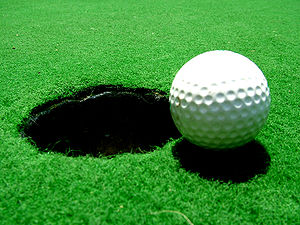 Image via Wikipedia
Image via WikipediaThe exact origin of golf is unknown. Some historians believe the earliest form of golf may have emerged in Greece, where ancient shepherds hit stones with their staffs. However, the game as we know it today had its origins in St. Andrews, Scotland, around 1744. In 1888 the first officially recorded golf club was established in Yonkers, New York, by three Scotsmen. This first course had six holes scattered through cow pastures and an apple grove and was named in honor of their Scottish homeland course, St. Andrews. Today a regulation course has 18 holes and may cover as many as 250 acres of beautifully groomed countryside. Golf is enjoyed today as a popular recreational activity. It can lead to various levels of competition. Golf is also a growing spectator sport, with professional and amateur tournaments becoming very popular.
Playing the Game
The object of the game of golf is to hit a small, hard ball (the golf ball) as few times as is necessary for it to travel from its starting point, on the tee, into the hole located on each green. The golf ball is struck with clubs designated as woods or irons. Each player must hit his or her own stationary ball in the desired direction and for the desired distance, using one of a variety of clubs of assorted lengths and shapes. Each attempt to strike the ball, whether successful or unsuccessful, is called a stroke.
You may play a game of golf alone or in a group with one to three other players. Golf is played on golf courses with 9 or 18 holes. The holes vary in length from 85 to 600 yards and are generally referred to as short holes (85245 yards), medium holes (245445 yards), or long holes (445600 yards). The total yardage of a regulation 18-hole golf course varies from 5,600 to 7,200 yards.
In addition to the lengths of the holes, golf courses have other characteristics that provide challenges to players. Each hole begins from a teeing area (tee box) from which the first ball must be hit. Each hole ends on a green, which has a 4 1/4-inch diameter hole, or cup, cut down into the grass on the green. Between the tee and the green is the fairway. The course is designed with specific boundaries that are marked by out-of-bounds stakes. A player who hits a ball outside the boundary or into water is penalized by having one stroke added to the score.
All golf holes have the five components described: teeing area, fairway, rough, putting green, and cup (hole). The central path from tee to green is the fairway, and it is the preferred location for your ball's landing. These areas may be wide or narrow, smooth or rough, and may have trees and shrubs located within them. Unfortunately, sometimes shots land in the taller grass left alongside the fairway, called the rough, which may also have natural obstacles such as trees and wooded areas. The ball may also land in sand or water hazards. Such challenges on the golf course are called hazards or trouble.
Are you looking for a good guide to help you improve your Golf Swing? For more information, tips and news on Golf please visit http://www.mygolfplace.net. Article Source: http://EzineArticles.com/?expert=Kristie_Haller |

No comments:
Post a Comment